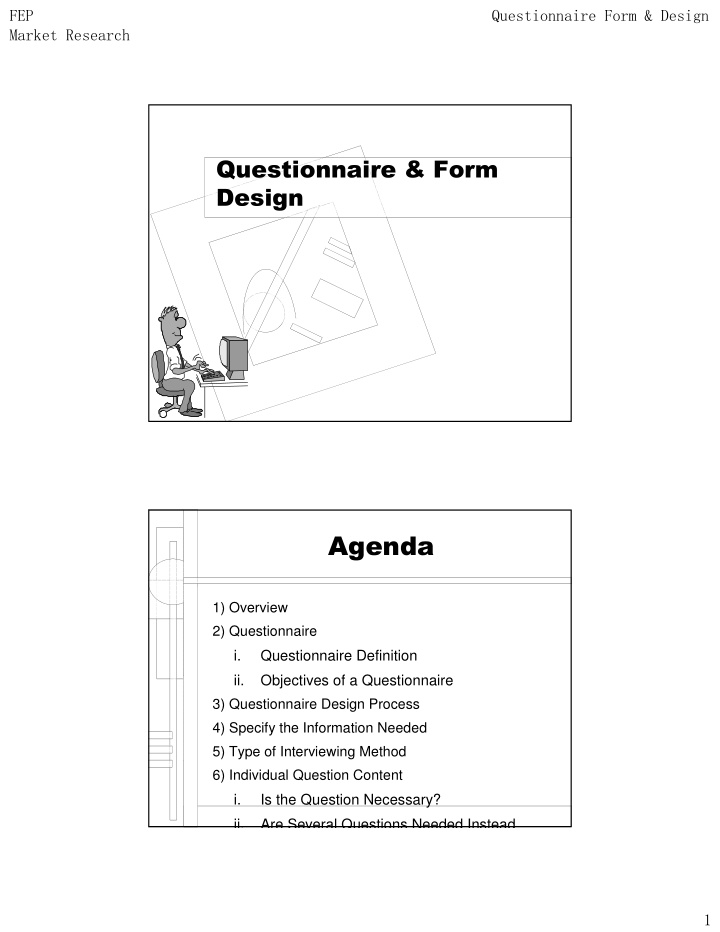



��� ��������������������������� ��������������� ��������������������� ������ ������ 1) Overview 2) Questionnaire i. Questionnaire Definition ii. Objectives of a Questionnaire 3) Questionnaire Design Process 4) Specify the Information Needed 5) Type of Interviewing Method 6) Individual Question Content i. Is the Question Necessary? ii. Are Several Questions Needed Instead �
��� ��������������������������� ��������������� ������ 7) Overcoming Inability to Answer i. Is the Respondent Informed? ii. Can the Respondent Remember? iii. Can the Respondent Articulate? 8) Overcoming Unwillingness to Answer i. Effort Required of the Respondent ii. Context iii. Legitimate Purpose iv. Sensitive Information v. Increasing the Willingness of Respondents ������ 9) Choosing Question Structure i. Unstructured Question ii. Structured Question 10) Choosing Question Wording i. Define the Issue ii. Use Ordinary Words iii. Use Unambiguous Words iv. Avoid Leading or Biasing Questions v. Avoid Implicit Alternatives vi. Avoid Implicit Assumptions vii. Avoid Generalizations & Estimates �
��� ��������������������������� ��������������� ������ 11) Determining the Order of Questions i. Opening Questions ii. Type of Information iii. Difficult Questions iv. Effect on Subsequent Questions v. Logical Order 12) Form & Layout 13) Reproduction of the Questionnaire 14) Pretesting ������������������������ • A questionnaire is a formalized set of questions for obtaining information from respondents. �
��� ��������������������������� ��������������� �������������� ���������� • It must translate the information needed into a set of specific questions that the respondents can and will answer. • A questionnaire must uplift, motivate, and encourage the respondent to become involved in the interview, to cooperate, and to complete the interview. • A questionnaire should minimize response error. ����������������������� ������������������������ Youth research (YR) of Brookfield, Connecticut, conducts an omnibus survey of children every quarter. Typically, YR interviews 150 boys and girls between ages 6 and 8, along with 150 boys and girls between ages 9 and 12. YR uses mall intercepts of mothers to recruit for its one-on-one interviews, which last eight minutes. The study obtains children’s views on favorite snack foods, television shows, commercials, radio, magazines, buzzwords, and movies. �
��� ��������������������������� ��������������� ����������������������� ������������������������ YR intentionally keeps its questionnaire to eight minutes because of attention span limits of children. YR President Karen Forcade notes that some clients attempt to meet all their research objectives with one study, instead of surveying, fine-tuning objectives, and re-surveying. In doing so, these clients overlook attention limits of young respondents when developing questionnaires. “The questionnaires keep going through the approval process and people keep adding questions, ‘Well let’s ask this question, let’s add that question, and why don’t we talk about this also,’” Forcade said. “And so you end up keeping children 25 minutes in a central location study and they get kind of itchy.” The response error increases and the quality of data suffers. ����������������������� ������������������������ Forcade notes other lessons from interviewing children. When asking questions, interviewers should define the context to which the question refers. “It involves getting them to focus on things, putting them in a situation so that they can identify with it,” Forcade said. “For example, when asking about their radio listening habits, we said, ‘What about when you’re in Mom’s car, do you listen to the radio?’ rather than, ‘How often do you listen to the radio? More than once a day, once a day, more than once a week?’ Those are kind of big questions for little children.” Questionnaires designed by Youth Research to obtain children’s views on favorite snack foods, television shows, commercials, radio, magazines, buzzwords, and movies attempt to minimize response error. �
��� ��������������������������� ��������������� ���������������������������� ������������������������������ ������������$��������������������%����� ��������������!������������������������������ ��������������������������������������������������������������� ����������������� ����� ����������������������������� �����������������������"������� ������������������������#����������� �������������&��������'����� ��������������������������� (���������)�������#��*������� ������������������������ ����� � • The first step in questionnaire design is to specify the information needed. • This is also the first step in the research design process �
��� ��������������������������� ��������������� !���������"�������#����$��������� � ��������������������� Mail Questionnaire • Please rank order the following stores in order of your preference to shop at these stores. Begin by picking out the one store that you like most and assign it a number 1. Then find the second most preferred department store and assign it a number 2. Continue this procedure until you have ranked all the stores in order of preference. The least preferred store should be assigned a rank of 10. No two stores should receive the same rank number. Store Rank Order 1. Benetton ____________ 2. Stradivarius ____________ 3. Salsa ____________ 4. Bershka ____________ 5. Sara ____________ 6. Maluka ____________ 7. Pinkie ____________ 8. Mango ____________ 9. Americo Tavar ____________ 10. Morgan ____________ �
��� ��������������������������� ��������������� Telephone Questionnaire • I will read to you the names of some stores. Please rate them in terms of your preference to shop at these stores. Use a ten point scale, where 1 denotes not so preferred and 10 denotes greatly preferred. Numbers between 1 and 10 reflect intermediate degrees of preference. Again, please remember that the higher the number, the greater the degree of preference. Now, please tell me your preference to shop at .......(READ ONE STORE AT A TIME) Store Not So Greatly Preferred Preferred 1. Benetton 1 2 3 4 5 6 7 8 9 10 2. Stradivarius 1 2 3 4 5 6 7 8 9 10 . . . 10. Morgan 1 2 3 4 5 6 7 8 9 10 Personal Questionnaire • (HAND STORE CARDS TO THE RESPONDENT). Here is a set of store names, each written on a separate card. Please examine these cards carefully. (GIVE RESPONDENT TIME). Now, please examine these cards again and pull out that card which has the name of the store you like the most, i.e., your most preferred store for shopping. (RECORD THE STORE NAME AND KEEP THIS CARD WITH YOU). Now, please examine the remaining nine cards. Of these remaining nine stores, what is your most preferred store for shopping? (REPEAT THIS PROCEDURE SEQUENTIALLY UNTIL THE RESPONDENT HAS ONLY ONE CARD LEFT) Store Rank Name of the Store 1. 1 __________________ 2. 2 __________________ . . . 10. 10 __________________ �
Recommend
More recommend